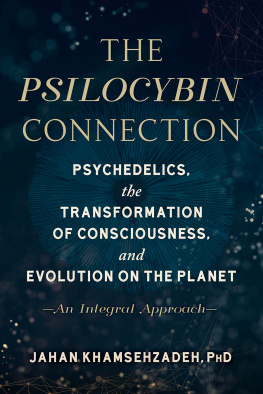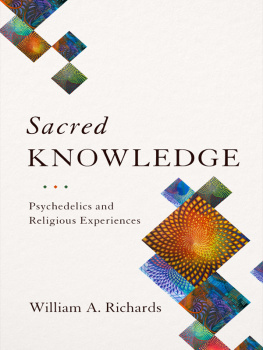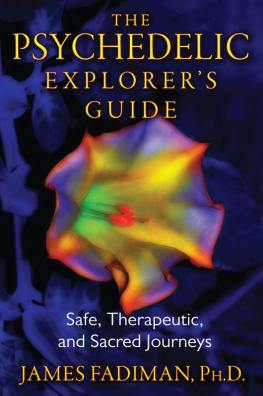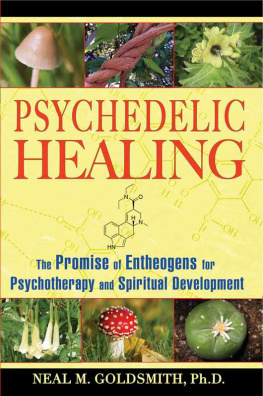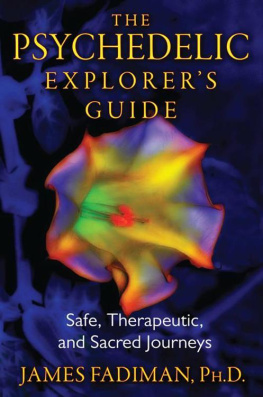

With love to Susan and Becca.
You are my sunlight and sky, my clover leaf and pine.
THE PSYCHEDELIC FUTURE OF THE MIND

With intelligence, keen insight, deep knowledge, and a wonderful ability to imagine a future illuminated by the powerful interaction between entheogens and the seeking human mind, Thomas Roberts pulls off a visionary book about the most fascinating subject imaginable.
TOM SHRODER, AUTHOR OF OLD SOULS AND FIRE ON THE HORIZON
Tom Roberts is one of the few elder statesmen of the psychedelic world concerned with the inevitable social and medical repercussions arising from the continued worldwide use and growing medical and governmental acceptance of entheogens. I find his speculations and their implications wise and innovative.
JAMES FADIMAN, PH.D., AUTHOR OF THE PSYCHEDELIC EXPLORERS GUIDE
Robertss work in the area of entheogensmans use of psychedelic substances in the context of religious rite or spiritual growthhas sought to replace popular uninformed hysteria with actual facts and, through critical examination, illuminate the ways in which our brains process and interpret our perceptions. He has earned his place among the best inner explorers of our time.
WILL DRESSER, AUTHOR OF SACRAMENT OF FEAR AND THE METHUSELAH MAN
Robertss book is a tour de force in the nascent field of psychedelic studies. The Psychedelic Future of the Mind proposes bold new research directions and methodologies that intrepidly advance what psychedelic research can become. A guide for researchers and the general public alike, this book promotes paths to integrate the power of psychedelic insights into both careers and daily life.
NESE DEVENOT, FOUNDER OF THE PSYCHEDEMIA CONFERENCE AND CONTRIBUTING EDITOR FOR REALITY SANDWICH
This Is My Song
(To be sung to the tune Finlandia)
This is my song, O God of all the nations,
A song of peace for lands afar and mine:
This is my home, the country where my heart is.
Here are my hopes, my dreams, my holy shrine.
But other hearts in other lands are beating,
With hopes and dreams as true and high as mine.
My countrys skies are bluer than the ocean,
And sunlight beams on clover leaf and pine.
But other lands have sunlight, too, and clover,
And skies are everywhere as blue as mine.
O hear my song, O God of all the nations,
A song of peace for their land and for mine.
LLOYD STONE
A Note to Readers
From my own experiences and through readings I have become increasingly respectful of the power of LSD and other psychedelic drugs. Like any powerful thing, they can be destructive or constructive, depending on how skillfully they are used. Among other things, they can concentrate your attention on the most vulnerable, most unpleasant parts of your mind. Therefore, psychedelic drugs should be explored only under the guidance of a qualified guide, one who has extensive psychedelic training. If you need assistance, most mental health professionals may be of little help, and some could even worsen your state, as they are currently mistrained concerning psychedelics.
Furthermore, street dosages are of unknown strength and questionable purity. Until the time you can explore your mind using psychedelics of known strength and purity under qualified guidance, within the law, I urge you to limit yourself to studying the literature and working within professional and other organizations for the resumption of legal, scientific, religious, or academic research.
INTRODUCTION
A Short Trail Guide to This Book
This book looks forward, not backward. Experiences beget ideas, and The Psychedelic Future of the Mind is an exploration of some ideas psychedelics engender. Based upon a collection of pieces of scientific research, case studies, anecdotes, and other information about psychedelics, this book asks, When all these pieces are assembled, what do they tell us about what it means to be a human, about our minds, and about the future?
Our answers will necessarily be partial, because their implications for what it means to be fully human and for what our society is are long and complicated. As researchers complete new studies, tomorrows findings will refine todays tentative ones. Some future discoveries will correct our errors. Others will confirm and elaborate our current views. And yet others will give birth to ideas we have not even thought of yet.
This is not a book about the discovery and history of LSD and all the strange and wonderful characters who are part of that story.
This is not a book about psychotherapy and the seemingly miraculous cures psychedelics sometimes produce.
This is not a book about how psychedelics plug in to receptor sites on neurons and set the brain adancing.
This is not a book of the I-drank-ayahuasca-puked-and-saw-theanaconda-goddess kind.
In a real sense, this book follows Jacob Bronowskis (1976) recipe in The Ascent of Man for how to speculate in order to advance knowledge: Thats the essence of science: Ask the impertinent question, and you are on your way to pertinent science. The questions embedded in this book are leads that deserve to be followed in more depth. The personal anecdotes and experimental findings reported here both stimulate these questions and are beginnings of answers, but we need additional evidence to answer the questions more conclusively, or even a bit more firmly.
I find it handy to think of the benefits of psychedelics as falling into two broad groups: mediating mystical experiences and revealing previously unknown aspects of our minds. Mystical experiences are powerful and overwhelming. They temporarily give a sense of setting aside ones identification with oneself, often with the realization of being a strand woven in a complex tapestry of perception, insight, and emotions. However, psychedelics can provide a different kind of experience, in which they give us access to the unconscious parts of our minds. They amplify events in our minds that are usually below our awareness so that we can become aware of them. I think the word psychomagnifiers fits them well.
These two categories parallel the two aspects of psychedelic psychotherapy identified by Stanislav Grof (1975, 1980): 1) powerful, emotionally positive, peak-experience psychedelic psychotherapy; and 2) less-powerful emotion-exploring psycholytic psychotherapy. The first uses large doses of psychedelics with the intent of producing a mystical experience. The latter uses lower doses to help people bring emotionally charged hidden events into consciousness.
Unlike many quieter mindbody states, mystical experiences shout so loudly we cannot ignore them. Part 1 of The Psychedelic Future of the Mind examines mystical experiences, with an emphasis on psychedelic effects, and listens to their message.
Part 2 is a rough parallel to psycholytic psychotherapy, but it pays more attention to the cognitive aspects of lower-dose sessions rather than to their intensely emotional effects, seeing psychedelics as tools to think with rather than focusing on their psychotherapeutic potential. Emotions and thinking constantly affect each other, of course. They are not divided by a wall but are twins from the same womb of our unconscious, albeit not identical twins.
Next page


